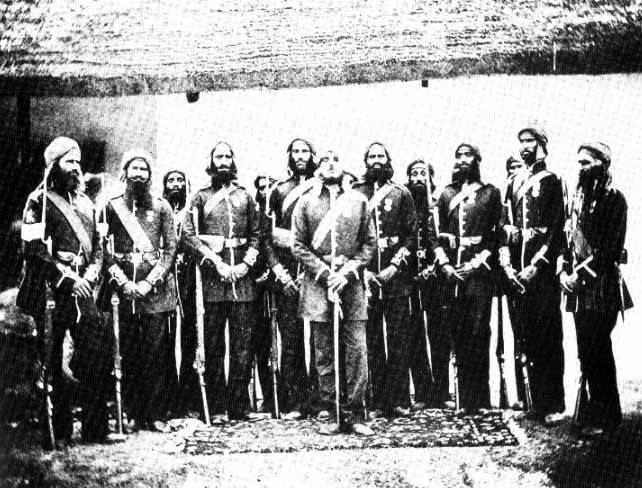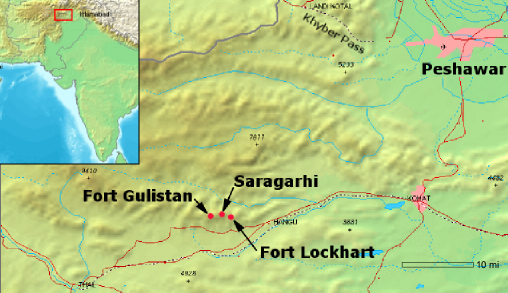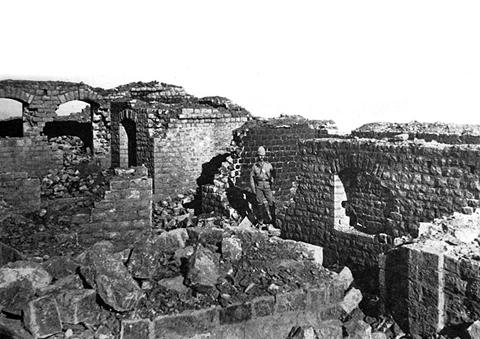THE BATTLE
Prior to September 12, numerous attempts were made by the Pathans to overrun the post but they failed due to calculated defensive actions by the Sikhs under the able leadership of Havildar Ishar Singh, the detachment commander at Saragarhi. Unbeknownst to him, the Pathans were planning a major offensive to decimate this vital post and the D-day was set for September 12, 1897, the H-hour at 0900 hrs.
The Pathan strategy called for the time-proven hammer and anvil maneuver, which is to block the reinforcement from Fort Lockhart (anvil) and strike Saragarhi with impunity (hammer). The chess pieces were in place and it was time for the Pathans to make the first move.
Havildar Ishar Singh peered through his binoculars from the watch tower of his post. What he saw numbed him, briefly. Through the magnified view, he could see columns upon columns and row upon rows of Pathans waving their swords and guns menacingly at the Sikhs. The dust kicked up by the thousands of horses temporarily blocked the sun rising over the horizon. The Pathan forces assembled before the Sikhs were colossal and raring to go.
Sepoy Gurmukh Singh, the detachment signaller, went up an elevated mound to set up his heliograph and began signalling to Fort Lockhart about their predicament: "ENEMY APPROACHING THE MAIN GATE ... NEED REINFORCEMENT".
Lt Col Haughton, Commanding Officer of 36th Sikh Battalion, rushed his troops to augment the outnumbered Sikhs but to no avail. The Pathans had systematically cut-off the supply route between Fort Lockhart and Saragarhi, a tactic to slowly strangle the Sikhs into submission.
Fort Lockhart transmitted back: "UNABLE TO BREAKTHRU ... HOLD POSITION".
Saragarhi flashed back: "UNDERSTOOD".
With that message, Lt Col Haughton had sealed the faith of the Sikhs at Saragarhi to certain death. As he watched from Fort Lockhart, Haugthon counted at least 10 enemy standards (each representing 1,000 tribesmen) facing the 21 Sikh soldiers.
Sepoy Gurmukh Singh passed on this message to Havildar Ishar Singh. As he assessed the grim situation facing him and his men, the Pathans began their attack.
Like wild hordes on the loose, the Pathans howling at top of their voices rode with guns blazing onto the Sikhs in order to breach the main gate of the post. One of the sepoys sounded the bugle as per Havildar Ishar Singh's command (signals during battle in the 18th and 19th centuries were via through bugle) and in a flash they formed up two lines abreast, one row in a squatting firing position and the other standing, as per the bugle's tone.
The Martini Henry breech loading rifle, the standard British Infantry rifle, was put through its paces.
Martini Henry rifles first entered service with the British Army in 1871 and quickly became its mainstay. Colonial units such as the Sikhs and Gurkhas only received them after all the British units were equipped .
It had only been a few months since these frontier regiments were equipped with these rifles, replacing the venerable Enfield. Capable of firing ten .303 calibre rounds a minute, it proved to be more than a match to the antiquated muzzle loading rifles possessed by the tribesmen.
Havildar Ishar Singh's piercing eyes stared at the group of tribal leaders ordering him to lay down his arms and surrender. A devout Sikh and fatherly figure to his unit, the troops under his command knew full well the ability of this North Western Frontier veteran.
Havildar Ishar Singh understood this terrain very well, its unpredictable climate and above all the character and fighting ability of the blood thirsty Pathan warriors.
The effective range of the Henry Martini rifle was around 600 yards (550m). Havildar Ishar Singh held his order to fire until the enemy closed in within 250m from his post.
Once the Pathans breached this marker, he yelled: "NA DARON AR SON JAB JAI LARON" ... in chorus with the soldiers: "NISCHEY KAR APNI JEEET KARON" ...
And then: "FIRE ... RELOAD ... FIRE AT WILL ..."
The .303 calibre was deadly and effective at this range, coupled with the grouping shots formed by the line abreast formations. The first line of the Pathan advance was completely decimated.
However, there was no time to reflect upon their success. With manual breech loading, the rifle had to be cocked every time to shoot. This was time consuming.
Furthermore, the Pathans who fell in the first wave were only part of the advance party that was sent to recon the Sikhs strength. From atop the post, Havildar Ishar Singh saw again thousands of Pathans in rows upon rows, waiting to charge against their beleaguered position. Now the Pathans knew the actual strength of the Sikhs and planned for a massive assault on all flanks, a multi-pronged attack designed to divide the outnumbered Sikhs into much smaller groups thereby ensuring weaker defensive formations.
The attack this time was with such fury that the earth around the fort shook as the Pathan horsemen thundered across the barren land to slice the Sikhs into pieces. Havildar Ishar Singh, unnerved by this onslaught, gave battle orders again: "SQUATTING SOLDIERS TO THE RIGHT ... STANDING SOLDIERS TO THE LEFT ... QUICKLY ... QUICKLY...", with clarity amid the chaos of battle.
The highly disciplined soldiers followed the orders like clock-work. The tribesmen attacked in two formations, one towards the main gate and the other towards the gap at the fort.
Havildar Ishar Singh calculated that at least 150 tribesmen rode in this wave. He could see only the white of their eyes as the tribesmen approached closer, masking their faces. Undeterred, he yelled their regiment battle cry together with his troops ... "JO BOLE SO NIHAL ... SAT SRI AKAL!"... and as the tribesmen came within range: "FIRE". The sounds of .303 exiting the barrels was deafening.
The tribesmen's attack was repulsed once again by the Sikhs due to superior marksmanship and motivation. Some tribesmen lay dead just yards away from the Sikh position denoting fighting at close quarters. The soldiers' ranks and ammunitions also started to dwindle at this juncture.
Out of the full strength of 21 soldiers at the start of the hostilities around 0900 hrs, by 1200, they were now down to 10, with the ever inspiring Havildar Ishar Singh still leading the men, despite being gravely injured by bullets and saber slashes. By this time, the Sikhs had repulsed seven charges by the tribesmen.
As the battle raged on without any respite, the ammunition gradually depleted and by 1400 hrs, Sepoy Gurumukh Singh signalled Fort Lockhart Battalion HQ: "LOW ON AMMO ... NEED AMMO ... URGENTLY!".
The heliograph had done its part in conveying the message. Lt Col Haughton sent his personal orderly to try and pass the ammunition to the trapped Sikhs, but again to no avail.
As the Pathans attacked again, the Sikhs, with less than 10 able bodied men, put up a stiff resistance and managed to repel the attack yet once again, but only briefly. The tribesmen now resorted to their traditional tactics - they set fire to the bushes and scrubs around Fort Saragarhi in a desperate attempt to subdue the Sikhs. Clouds of smoke blanketed the fort, making it impossible for the Sikhs to see the enemy.
Taking this opportunity and knowing full well that a frontal attack against the Sikhs was suicidal, the tribesmen used the smoke to mask their approach to the breach at the wall. Officers and soldiers at the Battalion HQ in Fort Lockhart could clearly see the approach of the tribesmen due to their elevated position above Saragarhi. Lt Col Haugton frantically signalled Saragarhi: "ENEMY APPROCHING THE BREACH ...!"
Havildar Ishar Singh, due to injuries sustained, had to drag himself towards the breach, accompanied by two other sepoys, to stop the tribesmen from entering the fort. Out of ammunition, all three of them fixed their bayonets and charged the tribesmen.
Overwhelmed by the sheer numbers facing them, all three fell were they stood, Havildar Ishar Singh providing leadership until the end. At the same time, the tribesmen entered the main gate due to the thinning of the defensive lines as a result of mounting casualties.
The main gate had been breached. However, hand to hand fighting still took place inside the fort, in full view from Fort Lockhart. Lt Col Haugton clenched his fist in frustration as there was nothing he could do to help the Sikhs.
Only 4 Sikhs were alive by the time the tribesmen breached the fort, with an additional sepoy, Gurumukh Singh, in the nearby mound providing up to date situation report via heliograph.
Out of ammunition, they did not lay down their weapons; instead, they formed an all round defensive position with their backs against each other, their bayonets pointing outwards.
The onslaught of the tribesmen soon reached its feverish peak: a force of nearly a hundred converged on the fort and hacked the valiant Sikhs into pieces, but not before the Sikhs took a few heads with them. From Lockhart, soldiers were in utter disbelief of the raw courage displayed down below at Saragarhi and the stiff resistance put up by the remaining Sikhs. They simply gasped in awe of the action unfolding before their very eyes.
At 1530 hrs Sep Sepoy Gurumukh Singh transmitted: "MAIN GATE BREACHED ... DOWN TO ONE ... REQUEST PERMISSION TO DISMOUNT AND JOIN THE FIGHT ...!"
Orders came back: "PERMISSION GRANTED!"
Sepoy Gurumukh Singh disassembled his heliograph device, picked up his rifle and went into the fort to join the fight. With exceptional presence of mind, courage and incredible tenacity, Sepoy Gurumukh joined in the fray.
Soldiers at Fort Lockhart saw him disappear into the thick of the battle, right into the tribesmen line. They could only hear him shouting at the top of his voice: "JO BOLE SO NIHAL ... SAT SRI AKAL! ... JO BOLE SO NIHAL, SAT SRI AKAL...!"
The third battle cry grew even more weaker, whilst Gurmukh Singh began choking on his blood as he stood there, bayoneting. Legend has it that he took down single-handedly 20 tribesmen before succumbing to the repeated slashes of the tribesmen's swords and the fire that was engulfing the post.
Sepoy Gurumukh Singh, the youngest of the group, was no more than 19 years old and the last to fall. He lay down with blood oozing from his wounds as crimson as the sun setting over the horizon.
Twitching, as his last breath left him, Sepoy Gurumukh Singh could hear in the deep recesses of his mind the melodic hymn of "DUKH BHANJAN" his mother had recited every evening in their home. He died, satisfied in the knowledge that he had done his duty!
Burnt-out interior of Saragarhi as it looked on 14th September, 1897
EPILOGUE
LT Col Haughton signaled his HQ in Punjab about the battle that had transpired. Within a few hours, tales of their bravery were making news across India.
The Governor General of India, the Earl of Elgin, wrote a personal telegraph to Queen Victoria describing the bravery of the Sikhs soldiers defending the post till their death.
The news reached the British House of Commons, and the tales of sacrifice of the 21 Sikh soldiers were narrated; tears flowed freely in the August house. At the end the of Chief Whip's speech, the entire parliament gave a rousing standing ovation to the Gallant 21, as their names were called out aloud in a symbolic roll call.
The collective courage of the 21 Sikh soldiers moved Queen Victoria so much that Her Majesty decreed that due to conspicuous gallantry and intrepidity beyond and above the call of duty displayed by the 21 soldiers, all of them shall be awarded the Indian Order Merit (IOM) posthumously. The IOM was the highest award for bravery given to colonial troops and it was equivalent to the British Victoria Cross.
This was the only time in history of warfare where each soldier who took part in the same battle was given the highest award. Additionally, Her Majesty decreed that the net of kin of these brave soldiers would each be given a stipend of 500 rupees and 50 acres of land.
Finally, a memorial cenotaph was to be erected near the place where all these 21 soldiers fell, as a perpetual record to the heroic action of these gallant soldiers who died at their posts in the defence of Fort Saragarhi, on September 12, 1897.
Without the stiff resistance of the 21 Sikh soldiers at Saragarhi, both Fort Lockhart and Gulistan would have fallen to the enemy. By defending their position long enough for the relief column to arrive with artillery support, the 21 Sikh soldiers became the crucial factor in turning the tide of battle in their favour.
The 21 Sikh soldiers fought on continuously for 7 punishing hours without food and water, completely surrounded, and pounded from all flanks. Unwearied by constant charges and mortal danger, they stood their ground against daunting odds, they repealed wave after wave of attack and fought till their last bullets. Even when out of ammunition, they did not abandon their post and instead chose to engage in a fatal hand to hand combat, till all made the ultimate sacrifice.
When the relief column arrived a day later, they saw the burnt out bodies of all the 21 Sikh soldiers, together with at least 600 dead bodies of the tribesmen strewn only yards in front of their position.
The Sikhs had faced 10,000 and had taken more than 600 of the enemy with them.
Havildar Ishar Singh (regimental number 165)
1. Naik Lal Singh (332)
2. Lance Naik Chanda Singh (546)
3. Sepoy Sundar Singh (1321)
4. Sepoy Ram Singh (287)
5. Sepoy Uttar Singh (492)
6. Sepoy Sahib Singh (182)
7. Sepoy Hira Singh (359)
8. Sepoy Daya Singh (687)
9. Sepoy Jivan Singh (760)
10. Sepoy Bhola Singh (791)
11. Sepoy Narayan Singh (834)
12. Sepoy Gurmukh Singh (814)
13. Sepoy Jivan Singh (871)
14. Sepoy Gurmukh Singh (1733)
15. Sepoy Ram Singh (163)
16. Sepoy Bhagwan Singh (1257)
17. Sepoy Bhagwan Singh (1265)
18. Sepoy Buta Singh (1556)
19. Sepoy Jivan Singh (1651)
20. Sepoy Nand Singh (1221)








